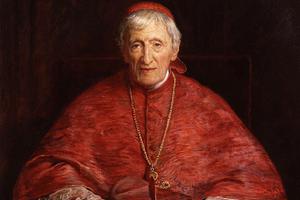St. John Henry Newman and America
It is no mere coincidence that the prayers of Americans have played such a crucial role in Newman’s cause and in his being raised to the altar.

The recent news that the Bishop of Northampton has declined to move forward with the cause for the canonization of G. K. Chesterton was not well received in the United States. At this year’s annual conference of the American Chesterton Society in Kansas City, the news was met with disappointment by the 500 Chestertonians in attendance. The general consensus was that it would take nothing less than a miracle to overcome the hierarchichal indifference and inertia with respect to Chesterton’s cause. Thankfully, Americans believe in miracles and are not averse to praying for them. It was, after all, the two confirmed miracles in answer to the prayers of Americans that paved the way for John Henry Newman’s beatification and canonization. First, in 2001, there were the prayers of Deacon Jack Sullivan, from Massachusetts, beseeching Newman’s intercession, which led to the miraculous healing of Deacon Sullivan’s spinal injuries. Then, in 2013, there was the miraculous healing in Chicago of Melissa Villalobos, which saved her life and that of her unborn child.
It is no mere coincidence that the prayers of Americans have played such a crucial role in Newman’s cause and in his being raised to the altar. The practice of the Faith is vibrant in the United States and devotion to Newman widespread. His influence on new converts to the Faith is well-documented, especially in the numerous testimonies given on The Journey Home, a weekly show focusing on converts on EWTN. One of the most prominent converts in recent years, Thomas Howard, paid tribute to Newman’s influence on his own conversion in the title of his book Lead, Kindly Light: My Journey to Rome, which alludes to the famous hymn which Newman wrote. Another prominent recent convert, Holly Ordway, cites Newman’s Grammar of Assent as being an important marker on her own conversion from atheism.
It is, however, in the field of education that Newman’s influence is felt most palpably. At colleges and universities across the length and breadth of the country, Newman Centers provide a hub for Catholic student activity on secular campuses. The first such Center in the United States was established in 1893, only three years after Newman’s death, at the University of Pennsylvania. Today, there are over 2,000 such Centers, all of which are inspired by Newman’s own wish that Catholic students at secular colleges and universities should form societies on campus to serve their spiritual and social needs and to offer witness.
Newman’s seminal work on education, The Idea of a University, has proved inspirational in the design of the curriculums of many of the new wave of Catholic colleges and universities that have sprung up across the United States in the past 40 or so years. The best of these are listed in The Newman Guide to Choosing a Catholic College, which is published by the Cardinal Newman Society, one of the most dynamic and effective organizations on the Catholic scene today. Founded in 1993, the mission of The Cardinal Newman Society is to promote and defend faithful Catholic education in the face of what it calls the “creeping secularism in Catholic education that has often corrupted teachings and behaviors – both inside and outside the classroom – and replaced authentic Catholic identity with bland conformity to a declining culture.”
It is of little surprise that the beatification and canonization of Newman has increased interest in his own words and works. To offer but two examples of this renewal of interest, the Augustine Institute has published Waiting for Christ: Meditations for Advent and Christmas, the success of which has prompted a follow-up volume, The Tears of Christ: Meditations for Lent, both of which consist of extracts from Newman’s sermons, selected and edited by Christopher O. Blum, Dean of the Augustine Institute’s graduate program in theology. Dr. Blum embarked on a speaking tour in early October, in the days prior to the canonization, and, on Oct. 13, the date of the canonization itself, the present author gave a lecture in Washington, DC, for the Institute of Catholic Culture on “The Heart of a Saint: The Spiritual Influence of Cardinal John Henry Newman,” which focused on Newman’s life and legacy, including his controversial conversion, his groundbreaking work in philosophy and theology, and, last but not least, his position as the father of the Catholic literary revival.
As an Englishmen living in the United States, the present author confesses a sense of patriotic pride that St. John Henry Newman, that most quintessential of English writers, should have won such a following on this side of the Atlantic. And yet, when all is said and done, a saint is not for any one particular country but for all peoples and all cultures, and for all time.
This article first appeared in the U.K.’s Catholic Herald and is republished with permission.
- Keywords:
- john henry newman

















